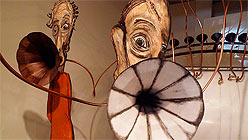On the surface, there isn’t much to Perpetual and Furious Refrain, Brent Green’s solo show at the Berkeley Art Museum’s MATRIX Gallery. The bulk of the show consists of film clips, not to mention one plus-sized, kinetic sculpture: a giant phonograph that uses a choir of interconnected, figurative sculptures as its mouthpiece. Based on these few items, I’m meant to question what it means to create, to love, to hope and believe, which I do — mostly because of the films — but I’m not sure I like the implications of Green’s answers.
Walking into the gallery, the first thing a visitor experiences is the looping soundtrack of the choir (based on a style of singing called shape-note singing), followed closely by the impression of somehow stumbling upon a grove of undulating trees, except they’re not trees, but very, very tall people, cut out of wood. Munch’s figure from The Screamwould not look out of place next to these giants, except for the fact that they all have gramophone horns where their mouths should be and are connected by long, copper tubes to grooves cut into a horizontally-placed, plastic tub, about 5 feet in diameter. It’s a version of one of the first forms of sound-recording technology (Edison’s wax cylinder), and its ceaseless rotation means that none of those choir members (nor the viewer) ever gets a break. No wonder one of them looks like he’s flipping me off.
The sculpture (and the exhibit) correspond with the Pacific Film Archive’s screening of Green’s film, Gravity Was Everywhere Back Then, on June 16 and is more of a must-see than the exhibit, if just for its unique visuals and custom-built sets. Green, a Pennsylvania-based filmmaker, has garnered well-deserved attention over the last few years for his stop-motion animated shorts. Dark and wistful, the films flicker and jump and stutter as Green’s crackly voice narrates modern-day parables (based on his own writings) over melancholic soundtracks, managing to mix Jan Svankmajer with William Kentridge and a heavy dose of neo-Folk.
Gravity is Green’s first full-length stop-motion film. It tells the story of Leonard Wood, a hardware store clerk who quits his job to build a house specially adapted to heal his wife (Mary) from cancer. Even after Mary’s death in 1972, Leonard continued building, until a fall off the roof forced him to sell the house to pay for his subsequent confinement in a local nursing home. The house was demolished, but Green obtained the plans and rebuilt the entire structure on his property in Pennsylvania, which is where Gravity was filmed. The film is as much about Green’s project (the recreation) as it is about Leonard’s (the original construction), and it is by paralleling their labors that Green investigates what it means to believe, to create, and to love.
Despite my inclinations to let go and enjoy Green’s works, I found myself unable to embrace them. Green tends to romanticize the archetypal creator: Edison, Noah, Leonard Wood, and even himself — the composer/builder of the perpetual and furious refrain from which the choir can’t escape. Even more unsettling — for me — are the moments of naive righteousness, which hint that there are some ways of being an artist and maker that are purer than others.


